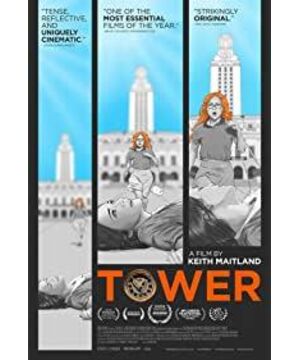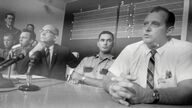1. Summary of the story
On August 1, 1966, after killing his wife and mother, Charles Whitman, a 25-year-old engineering student, mounted a shotgun on the tower of the University of Texas at Austin, and randomly shot passersby until two police detectives knew about it. It was shot dead with the assistance of Allen Crum, a clerk of the campus gift shop in the internal structure of the school tower. The incident resulted in 16 deaths and 33 injuries.
Second, is it a documentary?
In 2016, director Keith Maitland used a dynamic mask rotoscoping animation technique combined with real images to produce this movie about this event.
The first half of the film introduces to the audience the ins and outs of the events that took place on the day in a way similar to a crime thriller, with interview clips from the parties involved. It wasn't until halfway through the movie, during the classic point of no return period, that the audience saw the real interviewee's image for the first time. Only then did the audience realize that this was an interview 50 years later, and all the previous sounds and images were played by actors.
Karel Ritz and Gavin Miller wrote in the book "Film Editing Techniques" that the fundamental difference between feature films and documentaries is that feature films mainly express plot development, while documentaries mainly elaborate themes. Obviously, this film is not a documentary in the strict sense. Most of the film's content is based on the director's dictation and reasonably restored imagination, and the director has adopted a large number of feature film expressions. This is obviously not in line with the three elements that make up the truth film defined by Jean Roush, namely 1, direct shooting of real life and rejection of fiction. (Most of the content of this film is fiction based on reality, and even the director abstractly expressed the hallucinations and mood of one of the victims in animation.) 2. Don’t write a script in advance, no professional actors are needed. 3. The filming of the film The group consists of only three people, namely the director, photographer and sound engineer. The director will edit the bottom of the film himself.
But since the birth of documentary, there has never been a standard rule for the definition of documentary. Although this film breaks many traditional methods of documentary production, it still follows the general shooting methods of subjective intervention, objective recording, and true reproduction of these three documentaries. So it is reasonable to classify this film as a documentary.
Three, the uncommon way to deal with the end
Although this film is a documentary, it is so special, especially in the last two scenes of the film, the screen
1) On August 1, 1966, the local evening news in Austin on the night of the incident. The host was reading the media's definition and views on this vicious incident, but in the middle he kept jumping on the many campus attacks that occurred around the 21st century. The news screen of the case.
2) Under the tower of the University of Texas at Austin in 2016, the animated images of the two victims of the 1966 shooting came into the lens, shady, and the film ended.
Similar to Waltzing with Balsh, the ending of this film also challenges the audience's traditional perception of documentaries and cartoons. The difference is that when the audience sees the end of waltzing with Balsh, they will realize that this is really a real documentary, and these horrible things have really happened. But the director at the end of the film gave another answer. At the end of the film is the director's subjective summary and imagination.
John Grierson’s definition of documentary contains two meanings. 1 documentary is a representation of reality; 2 documentary needs to be creatively dealt with when reappearing. No one requires documentary directors to be 100% documentary, so this ending is understandable.
This article will discuss whether this is a reasonable and good ending.
1. It should be noted that the interview of this film took place 50 years after the end of the incident. Any documentary and film are recording a specific history in some way. When the way of telling history changes, history Whether it has also changed accordingly, this is a question worth pondering. From this perspective, it is wise to extend time and space at the end of the film for 50 years. If the film stopped abruptly in 1966, then it would have lost its value to today's audiences. This documentary will also be downgraded from a movie to an ordinary documentary that will be broadcast on TV for 20 minutes every night at 22 o'clock. It is precisely because the director finally extended the time and space in which the story took place to the present day, the whole film is connected with the audience who saw the film today. It is precisely because campus shootings have continued to emerge after 1966 that this film has the meaning of being discussed.
2. In the penultimate scene of the film, the female victim of the year calmly said forgiveness and forgiveness. If the film ends here, then the whole film is limited to the tragedy that happened that day, and all feelings are limited to the participants of the event. With the addition of a news broadcaster’s announcement and interspersed with the tragic events that are still taking place in the 21st century, this problem has been magnified into a global social problem, and every audience here has become a tragic event. Participant, maker or victim.
The documentary director's cognition and interpretation of the subject is not one-way closed, but an interactive and open process. And this last ending obviously opened the door to interaction. The audience no longer passively accept the information delivered by the director, they also have a chance to think.
From this we can also see that although the first half of the film is dressed as a feature film, the director still completes the film strictly in accordance with the classic hermeneutical approach of documentary films.
First of all, the director brought his own doubts and questions to the audience step by step to restore everything that happened that afternoon (although the audience could not see the director’s question in the film, the director deliberately deleted it, which is a common way for documentaries to enhance the sense of reality. practice).
Then, the director further expresses the party's deeper thoughts from different angles.
In the end, the director and the parties raised their horizons in the cyclical dialogue, and the whole film was presented in an open attitude.
It can be said that although the penultimate scene is less than a minute, it is the most important scene in the entire film. Without it, the film will not be sublimated, it will become an old news, and the audience will not be able to reflect on it.
The final completion of a documentary requires the participation of the audience, because the true expression of the film's value depends on the audience's interpretation, experience and intervention.
3. Although this is not a general rule of documentaries, more and more documentary directors like to imply their opinions in the last shot of the film. This film is no exception.
This kind of hint is very clever, usually it is a long or short paragraph that seems meaningless, or it is an empty mirror that has nothing to do with all the previous content.
In the last scene of the film, the director rarely used the omniscient perspective. The audience saw all the details of this campus, and then the couple who was shot at the beginning walked into the lens, and the film ended. If the audience does not observe carefully, it is impossible to determine the year of the video, because the director did not add subtitles to remind the audience. Attentive viewers can only find out from the car model in the previous empty shot and the clothes of passers-by in this shot, ah, this is not 1966, this is 2016.
This is exactly a blindfold of the director.
The omniscient perspective makes the audience mistakenly believe that they know everything that is happening, but in fact the audience is completely in a position of passive acceptance, thus losing their thinking and judgment. This perspective will hurt the objectivity of the narrative to a certain extent.
Why did the director let the two people from 1966 walk on the campus in 2016?
In the previous 80 minutes, we saw the thoughts of all the parties involved in this incident. The director also gave the audience a chance to think, and each audience also had their own thoughts. Through these few seconds of footage, the director vaguely expressed his views at the last moment, and accompanied by Debussy's beautiful moonlight, the director unknowingly guided the audience to stand on the same stand as him. Therefore, this omniscient perspective is actually the director's intention. No matter whether the audience finds the director's subtleties in time and space, it is very likely that they will unconsciously stand on the same values as the director in the end.
Documentaries are subjective, prejudiced, and completely objective documentaries do not exist. So there is nothing wrong with the director's approach, and in my opinion it is very advanced.
View more about Tower reviews










